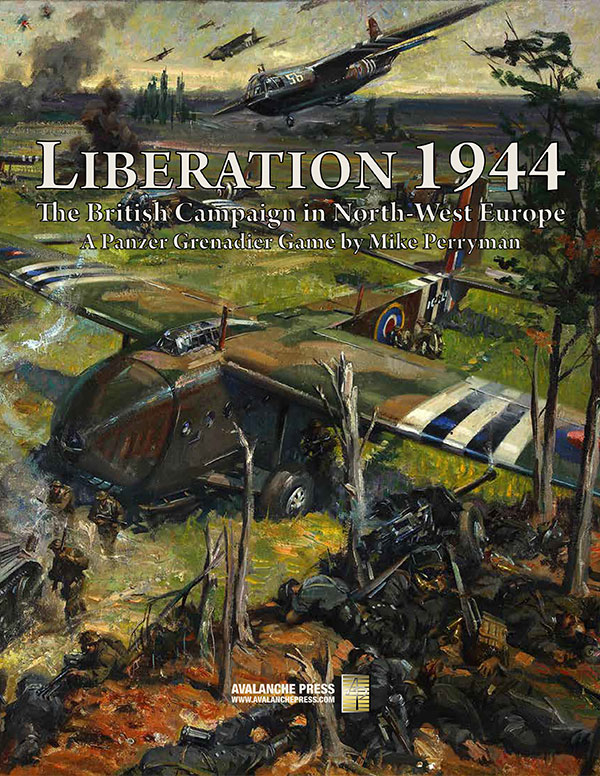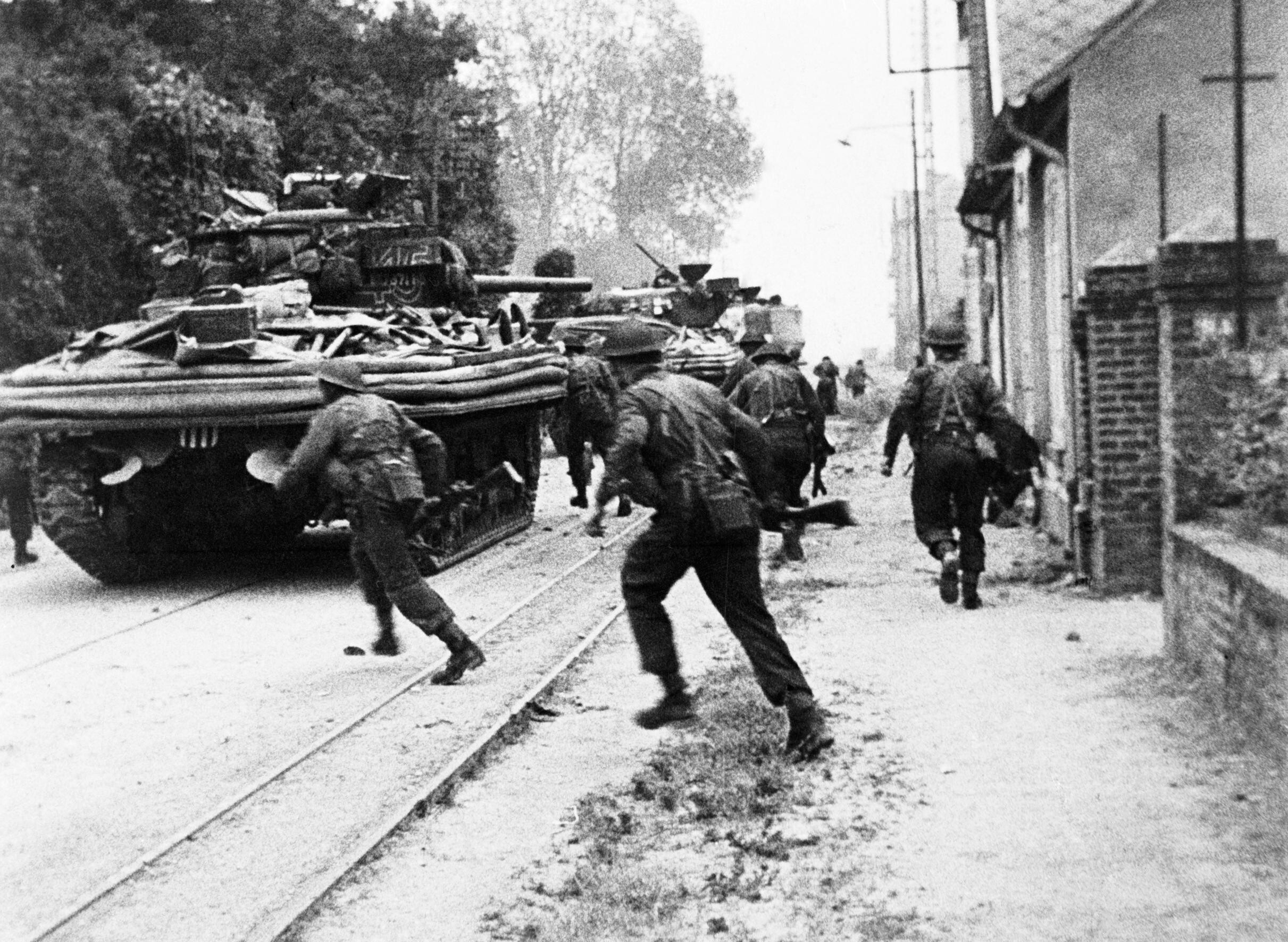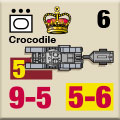| Liberation 1944:
Scenario Preview, Part Two
By Mike Bennighof, Ph.D.
October 2024
 While the British Army is the star of Panzer Grenadier: Liberation 1944 (that’s why the game has that title), the Germans also get a say. The infantry divisions aren’t very good, with some of them filled out by former Soviet prisoners, “ethnic Germans” with zero connection to modern Germany, and over-aged or infirm actual Germans. While the British Army is the star of Panzer Grenadier: Liberation 1944 (that’s why the game has that title), the Germans also get a say. The infantry divisions aren’t very good, with some of them filled out by former Soviet prisoners, “ethnic Germans” with zero connection to modern Germany, and over-aged or infirm actual Germans.
But the panzer divisions had been re-formed and equipped specifically to repel an Allied landing. And finally, they clanked into action. Let’s have a look at how that played out. You can see all of the previews here:
• Scenario Preview, Part One
• Scenario Preview, Part Two
• Scenario Preview, Part Three
• Scenario Preview, Part Four
• Scenario Preview, Part Five
• Scenario Preview, Part Six
• Scenario Preview, Part Seven
Chapter Two
The Germans Respond
German plans called for an immediate strong armored counterattack to push any Allies who came ashore in Normandy back into the sea. Ideas regarding just exactly when and where this attack would take place varied at each of the multiple layers of command bureaucracy stretching to the Supreme Leader himself.

Sherman Duplex Drive tanks on the Rue de Riva-Bella in Ouistreham, 6 June 1944.
Field Marshal Erwin Rommel, commanding Army Group B defending northern France, wished to defeat any landing right on the beaches. He had just three of the 11 panzer divisions in France available for this; the others remained under the control of the Supreme Leader by way of Panzer Group West, Supreme Commander West, Army Supreme Command and only then to the Supreme Leader. When the invasion took place, Rommel had returned home to southern Germany on leave, while the Supreme Leader had gone to his summer retreat at Berchtesgaden.
That made the German response to the invasion a rather disjointed affair. But they did respond.
Scenario Seven
Brazilian Hot Wax
6 June 1944
.jpg) Edgar Feuchtinger, commanding the 21st Panzer Division stationed directly behind the beaches, had gone to Paris with his girlfriend, a Brazilian stripper formerly employed in Hamburg. His subordinates could not contact him by telephone, and they lacked the authority to make the weighty decision on their own whether to attack landing beaches. Unable to contact their boss, they finally agreed in the late afternoon to enter battle without him. Edgar Feuchtinger, commanding the 21st Panzer Division stationed directly behind the beaches, had gone to Paris with his girlfriend, a Brazilian stripper formerly employed in Hamburg. His subordinates could not contact him by telephone, and they lacked the authority to make the weighty decision on their own whether to attack landing beaches. Unable to contact their boss, they finally agreed in the late afternoon to enter battle without him.
Conclusion
The attack kicked off at 1600 -- much later than the plan called for. The British blunted the east wing of the attack at Bieville claiming 10 enemy tanks destroyed. The west wing broke through the patchy defense and reached the coast at 2000 hours splitting Juno and Sword Beaches. But an hour later the Germans decided to withdraw when the 6th Airlanding Brigade passed overhead and landed behind them, potentially cutting them off. By that point Feuchtinger and his girlfriend had arrived and closeted themselves in an estate outside Caen; the general told his subordinates to carry on, and he did the same. Feuchtinger would receive the Knight’s Cross for his response to the invasion, but later be arrested for corruption, pardoned, returned to the front only to desert to the British. After the war, he took up a post in the West German Defense Ministry, became a KGB agent, and died of a “heart attack” while meeting his handler.
Notes
Now the Germans get to attack, with a mixed bag of tanks supported by infantry. The British are outnumbered but have high morale and some tank support of their own.
Daily Content includes no AI-generated content or third-party ads. We work hard to keep it that way, and that’s a lot of work. You can help us keep things that way with your gift through this link right here.
Scenario Eight
Young Criminals
7 June 1944
 The German plans for an immediate armored counter-attack fell apart for a variety of reasons: the Supreme Leader’s indecision, Edgar Feuchtinger’s insatiable sexual appetite, surprise and confusion among other German officers, and the unexpectedly formidable presence of Allied airpower. The SS political militia’s Hitler Youth Panzer Division arrived during the night, with both panzer divisions ordered to attack in the morning. The German plans for an immediate armored counter-attack fell apart for a variety of reasons: the Supreme Leader’s indecision, Edgar Feuchtinger’s insatiable sexual appetite, surprise and confusion among other German officers, and the unexpectedly formidable presence of Allied airpower. The SS political militia’s Hitler Youth Panzer Division arrived during the night, with both panzer divisions ordered to attack in the morning.
Conclusion
The Canadian 3rd Division, on the right (eastern) flank of the British 3rd Division, attacked first and pre-empted the German plan. The German commanders decided to let the Canadians over-extend themselves before launching their own attack. The fighting against the Canadians sucked in more and more of the 21st Panzer Division, leaving a lone panzer platoon to support the Hitler Youth’s effort. According to German accounts the SS militia managed to take Cambe anyway, and then drove the British back before pulling back themselves. This rings true as the British declined to follow when the Germans withdrew. In the long run, it made little difference. The piecemeal defensive commitment of available panzers doomed the envisioned grand offensive, likely sowing the seeds of later defeat.
Notes
It’s a meeting engagement on a long, narrow playing area. The SS juvenile criminals have very high morale and an edge in numbers, artillery, and mobility. The British are mostly on foot but have pretty good morale of their own and only need to frustrate the Germans to win.
Scenario Nine
Glidermen at Escoville
7 June 1944
 On D-Day the 2nd Ox and Bucks, part of the 6th Airlanding Brigade, landed in their Horsa gliders as the second lift of airborne troops. They promptly secured the Caen Canal and Orne River bridges in a daring coup de main with few casualties. A day later their objective, the town of Escoville, lay ahead guarded by the thinly-spread 21st Panzer Division. The big Hamilcar cargo gliders had landed armored support to spearhead the attack. On D-Day the 2nd Ox and Bucks, part of the 6th Airlanding Brigade, landed in their Horsa gliders as the second lift of airborne troops. They promptly secured the Caen Canal and Orne River bridges in a daring coup de main with few casualties. A day later their objective, the town of Escoville, lay ahead guarded by the thinly-spread 21st Panzer Division. The big Hamilcar cargo gliders had landed armored support to spearhead the attack.
Conclusion
The British fought their way into Escoville, despite a lack of anti-tank guns forcing them to rely on their toy-like PIAT anti-tank mortars. Two companies became cut off in Escoville, but a spirited counter-attack led by Major “Flaps” Edmunds restored contact. The battalion lost 80 men and seven officers; their commander, Lt. Col. Michael Roberts, had been badly injured when his glider crashed and had to be evacuated as well when he could no longer walk.
Notes
The British are on the attack, with a full-strength infantry battalion (backed by two platoons of the mighty Tetrarch airborne tank) advancing against a German recon battalion: armored cars, halftrack-mounted infantry and such. Both sides have very high morale. The British win by taking the key town, the Germans by not letting them do so.
And that’s all for Chapter Two. Next time, it’s Chapter Three.
You can order Liberation 1944 right here.
British Bulge Package
Liberation 1944 (Playbook ed)
Elsenborn Ridge
Britain's Battle of the Bulge
Retail Price: $190.97
Package Price: $150
Gold Club Price: $120
You can experience the British Bulge right here.
Sign up for our newsletter right here. Your info will never be sold or transferred; we'll just use it to update you on new games and new offers.
Mike Bennighof is president of Avalanche Press and holds a doctorate in history from Emory University. A Fulbright Scholar and NASA Journalist in Space finalist, he has published a great many books, games and articles on historical subjects; people are saying that some of them are actually good.
He lives in Birmingham, Alabama with his wife, three children, and new puppy. He misses his lizard-hunting Iron Dog, Leopold.
Daily Content includes no AI-generated content or third-party ads. We work hard to keep it that way, and that’s a lot of work. You can help us keep things that way with your gift through this link right here. |
